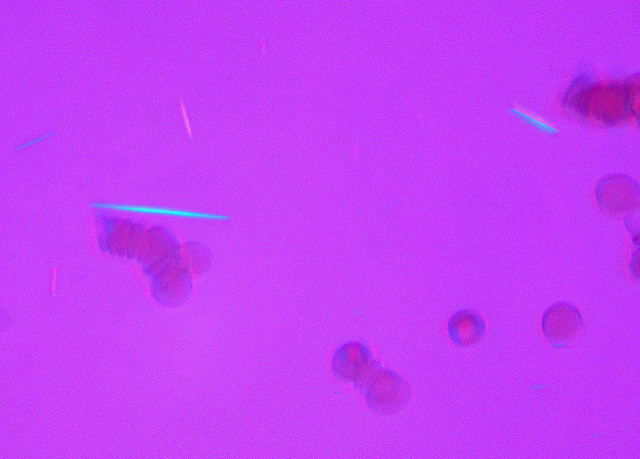Difference Between Gout and Pseudogout
What are Gout and Pseudogout?
Gout and pseudogout are the 2 most common crystal-induced diseases of joints (Arthropathy). However, the difference between the two is that Gout is induced by monosodium urate monohydrate crystals and pseudogout is induced by calcium pyrophosphate (CPP). The symptoms of both gout and pseudogout are same, however there are some notable differences which have been discussed below.

What is Gout?
Gout is a form of arthritis accompanied with severe pain, swelling, redness and soreness in the joints. The main cause for this health disorder is excessive uric acid in the blood stream. It usually targets the joint in the base of the big toe. It occurs without warning in the middle of the night. There are several stages through which gout progresses, and the patient experiences as different categories of gout.
- Asymptomatic hyperuricemia
- Acute gout
- Interval or inter-critical gout
- Chronic tophaceous gout

What is Pseudogout?
Pseudogout is also known as Calcium Pyrophosphate Dihydrate Crystal Deposition Disease (CPPD). It is a medical condition in which Ca crystals deposit in the joints, causing moderate pain, stiffness, redness and inflammation. Pseudogout is mostly uncommon than gout and osteoarthritis and is often misdiagnosed as gout. Pseudogout happens when calcium pyrophosphate crystals get precipitated in a joint and sett of an immune system response.
Difference between Gout and Pseudogout
-
Definition
Gout
Deposition of uric acid crystals in joints.
Pseudogout
CPPD – crystal deposition in joint cartilage.
-
Causes
Gout
Gout is caused by overabundance of crystalline monosodium urate (uric acid) deposition in the blood and fluids present in the joint. This condition is known as hyperuricemia. Diet high in certain high-purine foods, excessive alcohol, beer consumption and obesity cause the development of hyperuricemia and gout. Other causes include joint injury, surgery or sudden and severe illness, dehydration, chemotherapy, sweet sodas and Infection.
Pseudogout
Pseudogout is caused by the precipitation of calcium pyrophosphate dihydrate crystals in the large joints and that’s why it is also referred to as CPPD (Calcium Pyrophosphate Deposition Disease or CPPD). Pseudogout can even run in families, so it is believed to be a genetic condition. Some of other causes are ageing, degenerative arthritis. Acute arthritis of pseudogout can be triggered by dehydration. Pseudogout can also be caused by hyperparathyroidism. Other causes include excess iron, magnesium deficiency, overactive parathyroid gland, hypercalcemia (too much calcium in the blood).
-
Risk factors
Gout
Risk factors for gout are gender and ethnicity. Men are at greater risk of having gout than women, and African-American men possess greater gout risk than Caucasian men. Other risk factors include excessive weight, alcohol use, family history and genetics, medications like diuretics, sometimes called “water pills”, aspirin and cyclosporine, chronic renal failure, lead exposure and a trigger event, such as injury, surgery, or medical therapy.
Pseudogout
Risk factors for pseudogout are older age, joint trauma, genetic disorder, excessive calcium in the blood (hypercalcemia), mineral imbalances, underactive thyroid gland (hypothyroidism) or an overactive parathyroid gland (hyperparathyroidism).
-
Prevention
Gout
Gout attacks can be prevented with changes in lifestyle. Some of the preventive measures are avoiding purines found in alcohol, fish, beans, meat, and specific veggies like spinach and asparagus etc. Apart from this, controlling weight increase and some prescription medicines that help in preventing gout attacks.
Pseudogout
Pseudogout attacks cannot be prevented. However, taking low doses of colchicine may help to bring down the risk of future attacks. In another condition, such as a thyroid problem, that has caused pseudogout, treating that condition can help to minimize the symptoms of pseudogout and make them less severe.
-
Treatment
Gout
The gout symptoms can be reduced by using ice packs and by taking non-steroidal anti-inflammatory drugs (NSAIDs), corticosteroids and colchicine. Apart from medications, lifestyle changes like managing weight and uric acid lowering drugs, such as allopurinol, probenecid, sulphinpyrazone, Diuretics (thiazide) will help bringing down the symptoms. With treatment, many patients are able to alleviate their uric acid levels adequately to dissolve the Sodium urate crystals that cause gout and therefore the symptoms are relieved. Lifelong treatment is recommended to keep gout symptoms in control.
Pseudogout
There is no cure for pseudogout as such, but a combination of certain treatments and medications can reduce the pain and improve joint function. Nonsteroidal anti-inflammatory drugs (NSAIDs) like ibuprofen (Advil) are effective medications. Eliminating fluid containing the Calcium pyrophosphate crystals from the joint can alleviate pain and help reducing the inflammation. Corticosteroid injections are effective as well to relieve the pain and reduce inflammation. Lifelong treatment to prevent recurrent disease can be taken care with small daily doses of colchicine and optimal hydration and joint aspiration.
-
Length of symptoms
Gout
Length of symptoms in gout is mostly 5 to 12 days, but chronic attacks may show up over time.
Pseudogout
An episode of pseudogout can last from 5 – 14 days.
Summary of Gout Verses Pseudogout
The points of difference between Gout and Pseudogout have been summarized below:

- Difference Between Global Warming and Greenhouse Effect - May 18, 2024
- Difference Between Vaccination and Immunization - March 3, 2024
- Difference Between Selective Mutism and Autism - February 25, 2024
Search DifferenceBetween.net :
Leave a Response
References :
[0]McGill, N. W. (2000). Gout and other crystal-associated arthropathies. Best Practice & Research Clinical Rheumatology, 14(3), 445-460.
[1]MacMullan, P., & McCarthy, G. (2012). Treatment and management of pseudogout: insights for the clinician. Therapeutic advances in musculoskeletal disease, 4(2), 121-131.
[2]Ragab, G., Elshahaly, M., & Bardin, T. (2017). Gout: An old disease in new perspective–A review. Journal of advanced research, 8(5), 495-511.
[3]Image credit: https://www.flickr.com/photos/euthman/501118522
[4]Image credit: https://upload.wikimedia.org/wikipedia/commons/thumb/6/6e/Pseudogout_-_intermed_mag.jpg/640px-Pseudogout_-_intermed_mag.jpg
